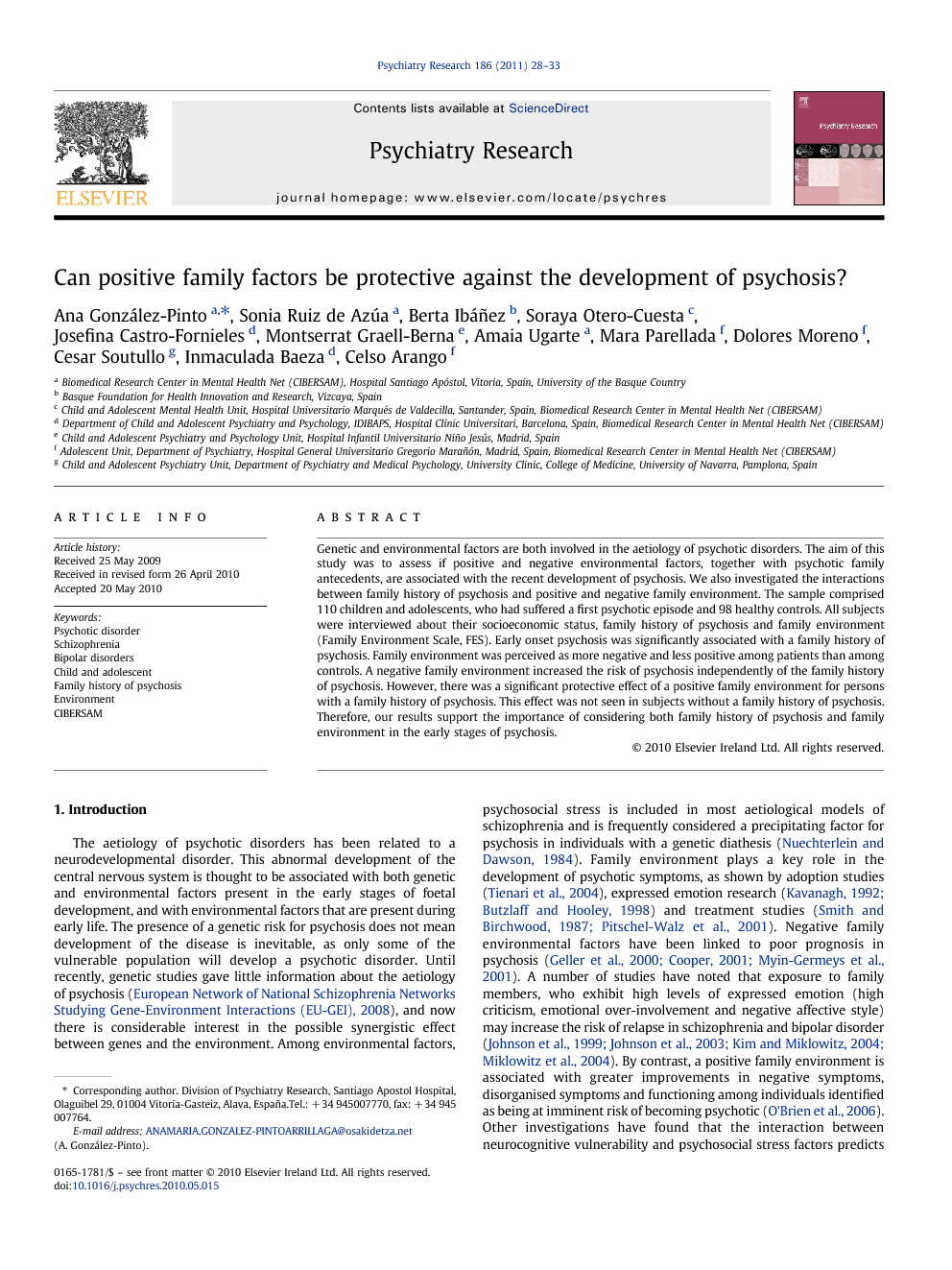Genetic and environmental factors are both involved in the aetiology of psychotic disorders. The aim of this study was to assess if positive and negative environmental factors, together with psychotic family antecedents, are associated with the recent development of psychosis. We also investigated the interactions between family history of psychosis and positive and negative family environment. The sample comprised 110 children and adolescents, who had suffered a first psychotic episode and 98 healthy controls. All subjects were interviewed about their socioeconomic status, family history of psychosis and family environment (Family Environment Scale, FES). Early onset psychosis was significantly associated with a family history of psychosis. Family environment was perceived as more negative and less positive among patients than among controls. A negative family environment increased the risk of psychosis independently of the family history of psychosis. However, there was a significant protective effect of a positive family environment for persons with a family history of psychosis. This effect was not seen in subjects without a family history of psychosis. Therefore, our results support the importance of considering both family history of psychosis and family environment in the early stages of psychosis.
The aetiology of psychotic disorders has been related to a neurodevelopmental disorder. This abnormal development of the central nervous system is thought to be associated with both genetic and environmental factors present in the early stages of foetal development, and with environmental factors that are present during early life. The presence of a genetic risk for psychosis does not mean development of the disease is inevitable, as only some of the vulnerable population will develop a psychotic disorder. Until recently, genetic studies gave little information about the aetiology of psychosis (European Network of National Schizophrenia Networks Studying Gene-Environment Interactions (EU-GEI), 2008), and now there is considerable interest in the possible synergistic effect between genes and the environment. Among environmental factors, psychosocial stress is included in most aetiological models of schizophrenia and is frequently considered a precipitating factor for psychosis in individuals with a genetic diathesis (Nuechterlein and Dawson, 1984). Family environment plays a key role in the development of psychotic symptoms, as shown by adoption studies (Tienari et al., 2004), expressed emotion research (Kavanagh, 1992 and Butzlaff & Hooley, 1998) and treatment studies (Smith & Birchwood, 1987 and Pitschel-Walz et al., 2001). Negative family environmental factors have been linked to poor prognosis in psychosis (Geller et al., 2000, Cooper, 2001 and Myin-Germeys et al., 2001). A number of studies have noted that exposure to family members, who exhibit high levels of expressed emotion (high criticism, emotional over-involvement and negative affective style) may increase the risk of relapse in schizophrenia and bipolar disorder (Johnson et al., 1999, Johnson et al., 2003, Kim & Miklowitz, 2004 and Miklowitz et al., 2004). By contrast, a positive family environment is associated with greater improvements in negative symptoms, disorganised symptoms and functioning among individuals identified as being at imminent risk of becoming psychotic (O'Brien et al., 2006). Other investigations have found that the interaction between neurocognitive vulnerability and psychosocial stress factors predicts psychotic thinking (Rosenfarb et al., 2000). Various environmental factors, including low socioeconomic status, are associated with a high frequency of psychotic disorders (Wicks et al., 2005 and Werner et al., 2007).
Previous work has suggested that environmental and genetic influences are not independent; they may interact synergistically, augmenting the effects of each other (van Os et al., 2003, van Os et al., 2004, Heim et al., 2006, Feinberg et al., 2007, Laucht et al., 2007, van Os et al., 2008 and EU-GEI European Network of Schizophrenia Networks for the Study of Gene Environment Interactions, 2008). Genes can impact on a psychotic disorder indirectly by making an individual more sensitive to the psychotogenic effect of an environmental pathogen (van Os et al., 2008). On the other hand, positive environmental factors can protect vulnerable individuals against developing the disease (Feinberg et al., 2007). However, the role of protective factors has received little attention. To date, only psychosocial treatments and low doses of antipsychotics have been shown to diminish the risk of developing psychotic episodes in subjects with prodromal symptoms (Nash et al., 2004, Royal Australian and New Zealand College of Psychiatrists Clinical Practice Guidelines Team for the Treatment of Schizophrenia and Related Disorders, 2005 and Strakowski et al., 2005). It is important to identify other potential protective factors of psychosis so that new treatments can be developed and for the primary prevention of severe mental disorders.
The study of environmental factors in early-onset syndromes seems especially important as younger people are more sensitive to positive and negative environmental factors (Ostman, 1989). This study was performed to assess if positive and negative environmental factors, together with psychotic family antecedents, are associated with the recent development of psychosis. Further, this research also investigates the interaction between genetic liability (using family history of psychosis as a proxy measure of genetic risk) and positive and negative family environment perception. Our hypothesis is that both positive and negative environmental factors are involved in the development of psychosis, and that both have a greater influence on patients with a positive family history of psychosis.


